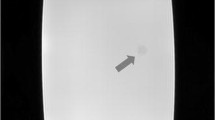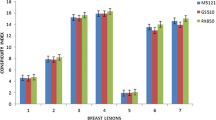Abstract
While previous research has determined the contrast detection threshold in medical images, it has focused on uniform backgrounds, has not used calibrated monitors, or has involved a low number of readers. With complex clinical images, how the Grayscale Standard Display Function (GSDF) affects the detection threshold and whether the median background intensity shift has been minimized by GSDF remains unknown. We set out to determine if the median background affected the detection of a low-contrast object in a clustered lumpy background, which simulated a mammography image, and to define the contrast detection threshold for these complex images. Clustered lumpy background images were created of different median intensities and disks of varying contrasts were inserted. A reader study was performed with 17 readers of varying skill level who scored with a five-point confidence scale whether a disk was present. The results were analyzed using reader operating characteristic (ROC) methodology. Contingency tables were used to determine the contrast detection threshold. No statistically significant difference was seen in the area under the ROC curve across all of the backgrounds. Contrast detection fell below 50 % between +3 and +2 gray levels. Our work supports the conclusion that Digital Imaging and Communications in Medicine GSDF calibrated monitors do perceptually linearize detection performance across shifts in median background intensity. The contrast detection threshold was determined to be +3 gray levels above the background for an object of 1° visual angle.






Similar content being viewed by others
References
National Electrical Manufacturers Association: Digital Imaging and Communications in Medicine (DICOM) Part 14: Grayscale Standard Display Function. National Electrical Manufacturers Association, Rosslyn, 2008
Samei E, Badano A, Chakraborty D, Compton K, Cornelius C, Corrigan K, Flynn MJ, Hemminger B, Hangiandreou N, Johnson J, Moxley-Stevens DM, Pavlicek W, Roehrig H, Rutz L, Shepard J, Uzenoff RA, Wang J, Willis CE: Assessment of display performance for medical imaging systems: executive summary of AAPM TG18 report. Med Phys 32:1205–1225, 2005
American College of Radiology: Practice guideline for digital radiography. Reston: 2007
IHE Technical Framework volume I Integration profiles. Chicago: 2007
Barten PGJ: Contrast sensitivity of the human eye and its effects on image quality. SPIE Optical Engineering Press, Bellingham, 1999
Wang J, Langer S: A brief review of human perception factors in digital displays for picture archiving and communications systems. J Digit Imaging 10:158–168, 1997
Legge GE, Foley JM: Contrast masking in human vision. J Opt Soc Am 70:1458–1471, 1980
Pelli DG: Uncertainty explains many aspects of visual contrast detection and discrimination. J Opt Soc Am A 2:1508–1532, 1985
Rovamo J, Luntinen O, Nasanen R: Modelling the dependence of contrast sensitivity on grating area and spatial frequency. Vision Res 33:2773–2788, 1993
Nachmias J, Sansbury RV: Letter: Grating contrast: discrimination may be better than detection. Vision Res 14:1039–1042, 1974
Burgess AE, Jacobson FL, Judy PF: Human observer detection experiments with mammograms and power-law noise. Med Phys 28:419–437, 2001
Burgess AE, Jacobson F, Judy P: Mass discrimination in mammography: experiments using hybrid images. Acad Radiol 10:1247–1256, 2003
Peli E: Suprathreshold contrast perception across differences in mean luminance: effects of stimulus size, dichoptic presentation, and length of adaptation. J Opt Soc Am A Opt Image Sci Vis 12:817–823, 1995
Peli E, Arend L, Labianca AT: Contrast perception across changes in luminance and spatial frequency. J Opt Soc Am A Opt Image Sci Vis 13:1953–1959, 1996
Wang J, Xu J, Baladandayuthapani V: Contrast sensitivity of digital imaging display systems: contrast threshold dependency on object type and implications for monitor quality assurance and quality control in PACS. Med Phys 36:3682–3692, 2009
Bochud F, Abbey C, Eckstein M: Statistical texture synthesis of mammographic images with super-blob lumpy backgrounds. Opt Express 4:33–42, 1999
Barten PGJ: Formula for the contrast sensitivity of the human eye. SPIE, San Jose, 2004
Ryan JT, Haygood TM, Yamal J-M, Evanoff M, O’Sullivan P, McEntee M, Brennan PC: The “memory effect” for repeated radiological observations. AJR Am J Roentgenol 197:W985–W991, 2011
Borjesson S, Hakansson M, Bath M, Kheddache S, Svensson S, Tingberg A, Grahn A, Ruschin M, Hemdal B, Mattsson S, Mansson LG: A software tool for increased efficiency in observer performance studies in radiology. Radiat Prot Dosimetry 114:45–52, 2005
Dorfman DD, Berbaum KS, Lenth RV, Chen YF, Donaghy BA: Monte Carlo validation of a multireader method for receiver operating characteristic discrete rating data: factorial experimental design. Acad Radiol 5:591–602, 1998
Dorfman DD, Berbaum KS, Metz CE: Receiver operating characteristic rating analysis. Generalization to the population of readers and patients with the jackknife method. Invest Radiol 27:723–731, 1992
Hillis SL: A comparison of denominator degrees of freedom methods for multiple observer ROC analysis. Stat Med 26:596–619, 2007
Hillis SL, Berbaum KS: Power estimation for the Dorfman–Berbaum–Metz method. Acad Radiol 11:1260–1273, 2004
Hillis SL, Berbaum KS: Monte Carlo validation of the Dorfman–Berbaum–Metz method using normalized pseudovalues and less data-based model simplification. Acad Radiol 12:1534–1541, 2005
Hillis SL, Berbaum KS, Metz CE: Recent developments in the Dorfman–Berbaum–Metz procedure for multireader ROC study analysis. Acad Radiol 15:647–661, 2008
Hillis SL, Obuchowski NA, Schartz KM, Berbaum KS: A comparison of the Dorfman–Berbaum–Metz and Obuchowski–Rockette methods for receiver operating characteristic (ROC) data. Stat Med 24:1579–1607, 2005
Medical Image Perception Laboratory. Available at http://perception.radiology.uiowa.edu/. Accessed July 27, 2010.
Starr SJ, Metz CE, Lusted LB, Goodenough DJ: Visual detection and localization of radiographic images. Radiology 116:533–538, 1975
Acknowledgments
The authors would like to acknowledge all of the readers who participated in this study for their support of this research.
Author information
Authors and Affiliations
Corresponding author
Rights and permissions
About this article
Cite this article
Leong, D.L., Rainford, L., Haygood, T.M. et al. Verification of DICOM GSDF in Complex Backgrounds. J Digit Imaging 25, 662–669 (2012). https://doi.org/10.1007/s10278-012-9478-2
Published:
Issue Date:
DOI: https://doi.org/10.1007/s10278-012-9478-2




